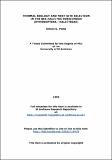Files in this item
Thermal biology and nest-site selection in the bee 'Halictus rubicundus' (Hymenoptera : Halictidae)
Item metadata
| dc.contributor.advisor | Willmer, Pat | |
| dc.contributor.author | Potts, Simon G. | |
| dc.coverage.spatial | 306 | en_US |
| dc.date.accessioned | 2017-03-16T09:47:27Z | |
| dc.date.available | 2017-03-16T09:47:27Z | |
| dc.date.issued | 1996 | |
| dc.identifier.uri | https://hdl.handle.net/10023/10478 | |
| dc.description.abstract | Aggregations of the ground-nesting bee Halictus rubicundus were found at several locations across the UK. The phenology, social organisation, nest architecture and foraging behaviour of this bee were described for the largest of these aggregations (Invergowrie, Scotland). This site was unusual in having an extremely high brood mortality due to the impact of an anthomyiid fly. Nest parasitism was found to be directly density-dependent and it lead to a marked decline in nest numbers over the period of this study, indicating the possible forthcoming extinction of the aggregation. The other sites contained smaller nesting aggregations and the level of parasitism was considerably less. There was a marked variation in size across UK populations and this was explained by a temperature rather than a latitudinal cline. There was no evidence from field or laboratory studies to suggest that this species is endothermic; H. rubicundus is purely a behavioural thermoregulator. The effect of size upon various rates of heat exchange were examined in the laboratory for both sexes, and related to behaviours observed at the nest-site. Thus the microclimatic windows for different activities were established. The abundance of flying individuals at the nest-site was highly predictable from ambient temperature and light intensity; with predictions during a single day being more accurate than those combining several days throughout the season. Furthermore the usefulness of standard operative temperatures in predicting flight activity was assessed. The thoracic temperature of both sexes depended on the prevailing ambient temperature and also on the size of the individual while either basking or flying. Body temperatures increased with both ambient temperature and head width. However when both these predictors were combined into a single model, then size was only a strong predictor at lower temperatures. These findings were used to explain many of the behavioural patterns observed at Invergowrie. The nest site selection behaviour of females was examined both within and across sites. H. rubicundus was able to utilise a range of edaphic and microclimatic conditions when choosing a site to excavate a nest. There were some factors with broad tolerances such as slope and hardness, and others with much narrower limits such as aspect, soil humidity and particle composition. The thermal advantages of having a warm nest meant that the most suitable areas were those with a southern aspect and a slope which maximised the absorption of solar radiation. Limited areas of substrate with the most desirable characteristics resulted in gregarious nesting ('limited substrate' hypothesis). There was a preference for softer soils, that were easier to dig, within a site with a low overall density; but in much denser aggregations problems of maintaining the structural integrity of a nest lead to the favouring of harder soils. The tendency to nest in close proximity to the natal nest (philopatry) complemented the 'limited substrate' hypothesis in producing an aggregation of nests. The spatial distributions of nests within aggregations were examined using nearest neighbour distance analyses; at low densities, microscale variation in substrate quality produced clumped patterns, whereas at high densities the risk of adjacent nests collapsing into one another forced nest spacing to be more regular. Findings concerning temperature dependence of nesting and foraging activities, and broader environmental controls on nest-site selection, are considered in relation to key aspects of bee biology: the origins and function of social behaviours, the conservation of, or provision of, nest-sites, and the utility of solitary bees as crop pollinators. | en_US |
| dc.language.iso | en | en_US |
| dc.publisher | University of St Andrews | |
| dc.subject.lcc | QL568.H3P7 | |
| dc.subject.lcsh | Halictidae--Nests | en |
| dc.title | Thermal biology and nest-site selection in the bee 'Halictus rubicundus' (Hymenoptera : Halictidae) | en_US |
| dc.type | Thesis | en_US |
| dc.type.qualificationlevel | Doctoral | en_US |
| dc.type.qualificationname | PhD Doctor of Philosophy | en_US |
| dc.publisher.institution | The University of St Andrews | en_US |
This item appears in the following Collection(s)
Items in the St Andrews Research Repository are protected by copyright, with all rights reserved, unless otherwise indicated.

